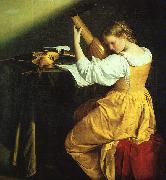
Oil On
Canvas, Real Flavor of Old Masters
|
Orazio Gentileschi
|
|||
|
|
|||
| 1563-1639 Italian Orazio Gentileschi Galleries Tuscan painter, b. Pisa. His real surname was Lomi, but he adopted his uncle name. He studied in Rome, where he was associated with Agostino Tassi in the decoration of palace interiors. Influenced by Caravaggio, Gentileschi developed a more softly luminous light and a cooler, more lyrical style. He also painted frescoes in Santa Maria Maggiore and in the Lateran. After spending several years in Genoa and in France, he settled in England (1626) at the invitation of Charles I. Gentileschi principal works include The Annunciation (San Siro, Genoa); Flight into Egypt (Louvre); Sibyl (Hampton Court, England); and Moses Saved from the Waters (Prado). He also painted numerous portraits. Artemesia Gentileschi was his daughter. | |||
|
|
|||
|
|
The Lute Player Orazio Gentileschi1.jpg Painting ID:: 1386 Visit European Gallery |
1610 The National Gallery of Art, Washington DC | |
Height Width |
INS/CM |
||
|
X |
|
||
|
|
|||
|
Orazio Gentileschi
|
|||
|
|
|||
| 1563-1639 Italian Orazio Gentileschi Galleries Tuscan painter, b. Pisa. His real surname was Lomi, but he adopted his uncle name. He studied in Rome, where he was associated with Agostino Tassi in the decoration of palace interiors. Influenced by Caravaggio, Gentileschi developed a more softly luminous light and a cooler, more lyrical style. He also painted frescoes in Santa Maria Maggiore and in the Lateran. After spending several years in Genoa and in France, he settled in England (1626) at the invitation of Charles I. Gentileschi principal works include The Annunciation (San Siro, Genoa); Flight into Egypt (Louvre); Sibyl (Hampton Court, England); and Moses Saved from the Waters (Prado). He also painted numerous portraits. Artemesia Gentileschi was his daughter. | |||
|
|
|||
|
|
The Lute Player new16/Orazio Gentileschi-869329.jpg Painting ID:: 40429 Visit European Gallery |
mk156 c.1626 Oil on canvas 144x130cm | |
Height Width |
INS/CM |
||
|
X |
|
||
|
|
|||
|
Caravaggio
|
|||
|
|
|||
| Italian Baroque Era Painter, ca.1571-1610 Italian painter. After an early career as a painter of portraits, still-life and genre scenes he became the most persuasive religious painter of his time. His bold, naturalistic style, which emphasized the common humanity of the apostles and martyrs, flattered the aspirations of the Counter-Reformation Church, while his vivid chiaroscuro enhanced both three-dimensionality and drama, as well as evoking the mystery of the faith. He followed a militantly realist agenda, rejecting both Mannerism and the classicizing naturalism of his main rival, Annibale Carracci. In the first 30 years of the 17th century his naturalistic ambitions and revolutionary artistic procedures attracted a large following from all over Europe. | |||
|
|
|||
|
|
The Lute Player new16/Caravaggio-275927.jpg Painting ID:: 41001 Visit European Gallery |
mk159 c.1595 Oil on canvas 94x119cm | |
Height Width |
INS/CM |
||
|
X |
|
||
|
|
|||
|
Theodoor Rombouts
|
|||
|
|
|||
| Flemish , b. 1597, Antwerpen, d. 1637, Antwerpen was a Flemish Baroque painter specializing in Caravaggesque genre scenes of card players and musicians. He studied under Abraham Janssens in Antwerp and was in Italy between 1616 and 1625, where he was heavily influenced by Caravaggio. | |||
|
|
|||
|
|
The Lute Player new24/Theodoor Rombouts-376756.jpg Painting ID:: 78634 Visit European Gallery |
ca. 1620(1620) Medium Oil on canvas Dimensions 111 x 98 cm (43.7 x 38.6 in) cyf | |
Height Width |
INS/CM |
||
|
X |
|
||
|
|
|||










